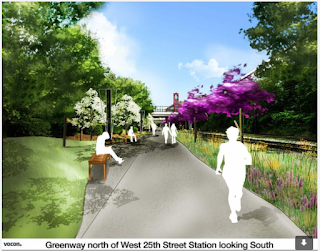 |
| Ohio City station-area develop- ments (CLICK TO ENLARGE) |
Consider:
 |
| Red Line Greenway (Vocon) |
 |
| Harbor Bay's Market Square development (HPA) |
But if you don't think that stunning scale of development is enough, then you're in luck. Because there's more:
Look for an announcement in 2019 regarding the former Brickhaus Towers/One Twenty West development, first proposed by Andrew Brickman. With a lot on his plate already, a larger, more prominent local developer is seeking to take over this site to deliver as many housing units as possible to the booming near-West Side. Sources asked that this developer not be named publicly as the company doesn't like to announce a project unless it is more than 90 percent certain the project will happen.
That, of course, means this project is far from certain. But this site is in a prime location. It's across Lorain Avenue from the GCRTA station, has an unobstructed view of downtown, is a short walk to the West Side Market and the West 25th business/restaurant district, and is next to the Towpath Trail plus the planned Red Line Greenway. The Scranton Peninsula development will be down the hill along the Cuyahoga River and won't block the views here.
 |
| Original plan for Brickhaus Towers/One Twenty West (HPA) |
Last but not least is the development of GCRTA-owned land along Columbus Road, above the Red Line and the planned alignment for the greenway. In the hopes of attracting a "high-quality, dense, mixed-use, transit-oriented development," GCRTA publicly issued a request for qualifications (RFQ) from developers so that a selection committee could choose the most capable company to whom the authority could sell or lease its land. The deadline for developers to respond was Oct. 11.
 |
| Rezoning changes approved by Cleveland City Council on Oct. 17. The blue rectangle shows an area larger than what GCRTA ultimately included in its development RFQ (CPC). |
However, a neighborhood rumor is that Sam McNulty, a proponent of mass transit and biking, is very interested in developing this property. His Duck Island 7 development at Columbus Road and Abbey Avenue, with townhomes selling for $500,000 to $600,000 each, is nearly sold out. And, on Nov. 3, McNulty posted on Instagram a photograph of a large roll of construction blueprints to be submitted to the city's Building Department for a large development. He pledged to "announce the details soon."
 |
| Sam McNulty's Nov. 3 Instagram post (Instagram) |
Cleveland City Council on Oct. 17 voted unanimously to rezone multiple parcels of land in the fast-growing Duck Island neighborhood (see map above). It followed the creation of a development masterplan based on public input. The land along the west side of Columbus Road, from Lorain to West 25th, was rezoned from semi-industry to "multi-family G-1" which allows a range of residential uses, from single-family homes to apartment buildings. The maximum square footage of a building on a property zoned G-1 is three times the lot area and can be up to 35 feet in height based on the street frontage. However, the Red Line right of way below Columbus Road is 25-30 feet lower.
 |
| Sam McNulty's Duck Island 7 townhomes (Mendo/UrbanOhio) |
GCRTA's RFQ stipulates that developers have the option to request additional land if a larger project is proposed. However, Rusnov emphasized that the Red Line Greenway is "distinct from the development site and is fully contained on a separate parcel of land."
 |
| GCRTA's Ohio City Red Line station (KJP) |
Increasingly, as living, working, shopping and playing becomes more popular in Ohio City and the adjoining Duck Island neighborhood, space is going to be at a premium -- especially near high-capacity public transportation stops like rail stations. Indeed, these latest developments show how much in demand this area is becoming.
END

With this in mind, maybe the RTA ( if it had the money....which it doesn't) should consider building a light rail system down Lorain Rd. bringing the economic boost to Cudell and West Bolevard neighborhoods. Or a rail system through Glenville and Colinwood, which desperately need revitalization.
ReplyDeleteWhile it is true that RTA has no money for rail expansions, others might. There was some interest in a Detroit Avenue streetcar, from Public Square, via the subway deck of the Detroit-Superior bridge, and west to Gordon Square/West Boulevard. It would have been paid for by developers forgoing their tax abatements and instead use the property taxes to retire a bond issue to build the streetcar line and to operate it. In exchange, developers would have their parking minimums reduced or eliminated (reducing the cost of construction by $15,000 to $20,000 per housing unit), and making it possible to tap Location-Efficient Mortgages. Such financing is pretty common in other cities, but is considered innovative in Cleveland if it is considered at all.
ReplyDelete